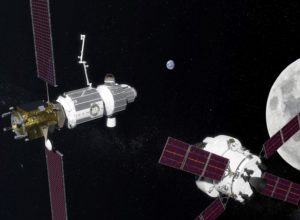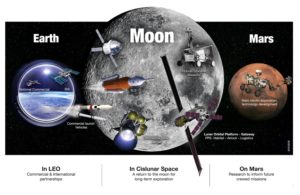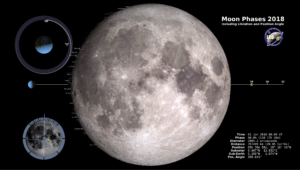
The LOP-G in orbit around the Moon. Look, but don’t touch.
There was real excitement in the lunar community last fall when Vice President Mike Pence announced, during a meeting of the reconstituted National Space Council, that the next step in human spaceflight would be our return to the Moon. Advocates for this direction felt enormous relief; at last, reason had returned to the strategic planning of NASA’s human program – a program stalled for the last decade, merely marking time. True enough, the new Orion spacecraft is being built and the new SLS launch system development continues; but with only one boilerplate flight of same (and that launched on an existing Delta-IV Heavy, not the SLS), many felt certain the Orion program was trapped in development hell.
The space policy directive put forth by the new Administration, one of returning to the Moon’s surface, was long overdue. It appeared that despite programmatic delays, a return to the Moon was back in the cards. But six months later, that direction, along with all of our earlier optimism, is now in question.
The first and biggest problem is that a year-and-half into President Trump’s administration, NASA still has no permanent Administrator. The nomination of Rep. Jim Bridenstine, a superb selection from any honest perspective, has been stymied in the Senate by the machinations of Florida’s two senators, Bill Nelson and Marco Rubio. Due to the narrow Republican majority in the Senate, the actions of these two have had an overstated impact on the nomination voting process. So, while Rep. Bridenstine’s confirmation vote is held up in the Senate, NASA has been unable to initiate the space policy direction called for by the Administration, because, in Beltway terms, it can do nothing, except continue to execute the existing program of record.
The current Acting Administrator Robert Lightfoot is retiring this month and no doubt another interim chief will be designated. Their job will be to see that the agency keeps running: whether towards somewhere, or in place, is irrelevant. Thus, plans made during the Obama administration, no matter how idiotic or irrelevant to our national strategic goals, are kept, adapted or simply, re-branded.
And that brings us to the development and deployment of the Deep Space Gateway (DSG, a.k.a., LOP-G, Lunar Orbital Platform-Gateway). This piece of space hardware is what’s left of the Obama-era Asteroid Redirect Mission, a plan almost universally derided by the space community, to capture an asteroid boulder, bring it to cislunar space and let a manned Orion vehicle study it. This bizarre scheme was adopted once it was found that a near-Earth asteroid suitable for a human visit did not exist. Aside from the utter pointlessness of such a mission, it seems we are on track to take the manned space development budget and spend it on this “Mini-Me” space station, one that cannot (other than for short periods) be permanently inhabited because of resupply problems, hard radiation environment and other considerations.
NASA has easily morphed the ARM into the DSG because they are essentially the same spacecraft – a solar electric propulsion (SEP) module, a habitation module and a docking collar. The LOP-G will be placed in what is called a rectilinear halo orbit, an elliptical path varying between 7000 and 70000 above the Moon. The idea is to make the LOP-G a test Mars transfer vehicle, in that SEP is being considered as a way to move cargo between Earth and Mars. As a staging node for going to the lunar surface, the LOP-G leaves a great deal to be desired, as it has both a high propulsive cost (greater than 2.4 km/s) and serious phasing problems for lunar arrival and departure. How does this square with the Trump administration’s call to return to the Moon?
Because (wait for it)…..LOP-G is in orbit around the Moon!
With this “wool-over-their-eyes” program, the agency has many believing that they have dutifully answered Vice-President Pence’s bold challenge for lunar return. And, mirabile dictu, it’s a “twofer,” as they’ve managed to keep their eye on the “real prize” – Mars.
Alas, if it seems too good to be true, it probably is. In fact, the LOP-G answers neither lunar nor martian mission needs particularly well. The location of the platform does not allow easy access to the lunar surface, and certainly not for a single-stage vehicle. Some independent means to get cargo and (probably) crew down to the Moon will have to be developed, which means that the LOP-G is irrelevant to lunar return. Mars mission architectures are in way too early a state of development to determine if the LOP-G is useful for them and likely to be fraught with additional complications. It would be much simpler, in each case, to assemble what you need in low Earth orbit and then go the destination of choice.
But NASA wants the DSG/LOP-G and so, there it is. But wait! How has NASA – an agency “operating” without a new Administrator for the past 18 months – continued to function and set policy direction without the Trump Administration’s pick at the helm? Easy – the continuing and permanent bureaucracy of the agency determines what policy or program it wants, slow-rolls any newly proposed changes or alterations to the previous policy, and eventually, what was in (slow) motion, stays in (exceedingly slow) motion – implemented by default, with the change agents eventually having to give up and go home. We are watching this process in action now.
Hang on – I thought that the newly reconstituted National Space Council was supposed to provide educated, adult supervision to the NASA bureaucrats? Surely, if the Vice President announces a new policy of lunar return, the Council will monitor NASA management and assure that the agency complies with that directive. In this case, it appears that such has not occurred. Or, more precisely, it appears that for some reason, the Council is convinced that NASA is complying with that directive. They certainly claim to be. New artwork of the LOP-G always shows the Moon in the background, so we must be going to the Moon, right? However, note the composition in the image above – the Moon, always in the background. Although I hesitate to conclude that the Council is deficient here, they appear unable to see through this slight-of-hand in order to direct difficult, pointed questions to the minions generating this smokescreen.
The biggest indicator that NASA has no interest in going to the lunar surface came with the recent announcement that the launch of a small mission called Resource Prospector – a mission designed to land at one of the Moon’s poles and sample polar volatiles – has been delayed, once again, this time until 2022. This relatively simple mission would be our first look at lunar polar ice, a mission critical to the idea of developing and using the resources of the Moon. So with this “delay,” it appears there is no plan for NASA to locate and examine lunar resources in order to learn and understand their potential implications for America’s national economy and its security. True enough, small commercial missions may get there before 2022, but we’re talking about a supposed national priority and the importance of being back on the Moon at a time when other countries are already moving ahead in this important cislunar arena.
When the White House asked for cost estimates for lunar return, no effort was made to realistically estimate the costs to develop a new lunar lander. My sources tell me that the old Augustine Committee/Aerospace Corporation estimates of 2009 were hauled out in response. I have discussed previously why that effort was seriously flawed and deficient; those cost estimates are from the 2007-2009 Altair effort and have no more relation to the real cost of new lander development than the cost of a B-17 has to a Space Shuttle.
Is there a solution to this on-going space policy problem, one that involves vital national interests? If Rep. Jim Bridenstine were to be swiftly confirmed and allowed to take office, would the ship correct its course? There is good reason to suspect that even in the case of that happy eventuality, due to the long delay in getting Bridenstine confirmed, we will still waste time and money on the LOP-G. The agency has convinced the White House and Congress that LOP-G is the first step towards going to the Moon, despite the falsity of their claim.
That said, a strong hand in the Administrator’s chair could help redirect some of the more egregious missteps in direction of the agency. A vigorous program of robotic prospecting missions to the lunar poles to gather key strategic data for the ice deposits could be instituted for a modest amount of money. Such data are crucial to almost any future lunar surface operations (and other eventual space destinations), at least to those who understand and are concerned about creating a new, affordable, extendable and productive spaceflight capability.
Have we lost the Moon? Perhaps not, but we are pretty close to it. Message to National Space Council: Please take the necessary time and initiative needed in order to clearly and independently understand the situation, then fulfill your mandate and hold NASA’s feet to the fire!




